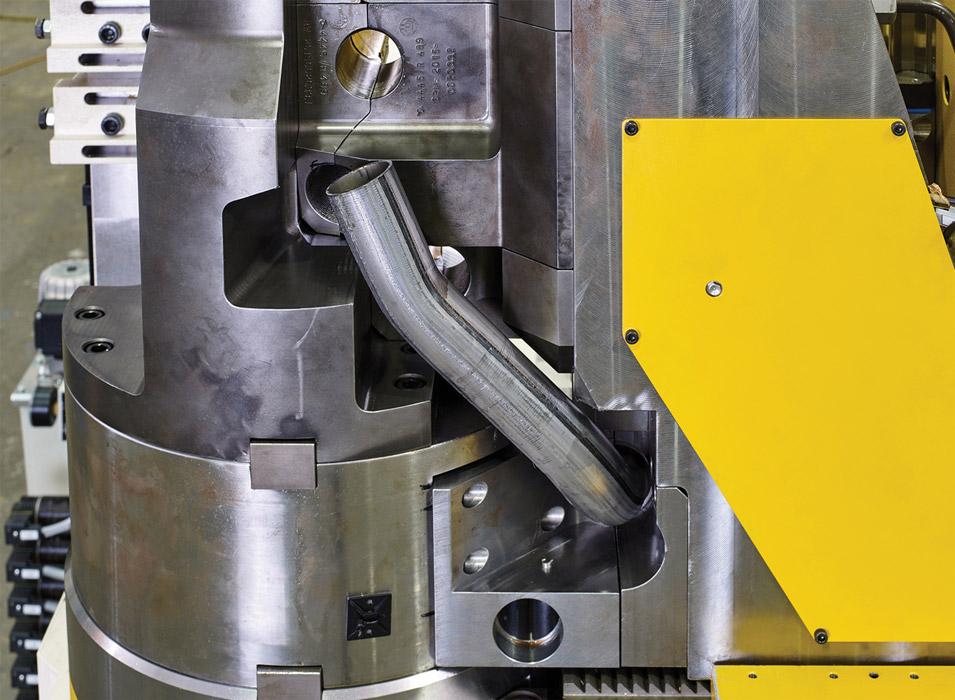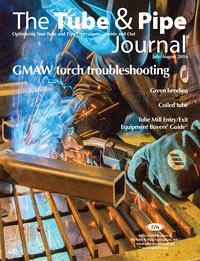- FMA
- The Fabricator
- FABTECH
- Canadian Metalworking
Categories
- Additive Manufacturing
- Aluminum Welding
- Arc Welding
- Assembly and Joining
- Automation and Robotics
- Bending and Forming
- Consumables
- Cutting and Weld Prep
- Electric Vehicles
- En Español
- Finishing
- Hydroforming
- Laser Cutting
- Laser Welding
- Machining
- Manufacturing Software
- Materials Handling
- Metals/Materials
- Oxyfuel Cutting
- Plasma Cutting
- Power Tools
- Punching and Other Holemaking
- Roll Forming
- Safety
- Sawing
- Shearing
- Shop Management
- Testing and Measuring
- Tube and Pipe Fabrication
- Tube and Pipe Production
- Waterjet Cutting
Industry Directory
Webcasts
Podcasts
FAB 40
Advertise
Subscribe
Account Login
Search
Tube fabrication equipment manufacturer takes a holistic view of sustainability
Bending, cutoff, lubrication, automation help to conserve precious resources
- By Eric Lundin
- July 7, 2016
- Article
- Tube and Pipe Fabrication
Sustainability and green technology, buzzwords just a few years ago, have achieved a permanent place in the manufacturing lexicon. Nonetheless, the reality is that industry still has a long way to go. According to calculations by the German Federal Statistical Office, material cost is about 45 percent of the gross production value, and energy isn’t cheap, so staying competitive is a matter of using resources sparingly and streamlining production processes to reduce consumption of these resources. Other resources, specifically labor and time, also warrant close attention because operator-friendly and safe production processes improve the work environment, and reducing cycle times help manufacturers meet delivery dates.
Manufacturers have been implementing resource-conserving technologies for years, and equipment developer Schwarze-Robitec illustrates the depth and breadth to which these can help in tube and pipe fabrication.
Cut, Bend, Cut
A conventional manufacturing sequence uses three process to make bent pipe components: an initial cut, a bend, and a final cut. To make this process more efficient, the company combined cutting and bending in a single machine. This enables bending and cutting pipe components from commercially available lengths in a single process step. It reduces material waste, cuts the cycle time, and eliminates two handling steps.
The cost reduction is greatest when fabricating high-value materials bent to make very short components. In common practice, mill lengths are cut in preparation for bending. These lengths often include extra material for clamping in the bender. After bending, the additional material is removed in a secondary cutting process. A typical process for a typical part, such as rotary bending to make manifold tubing, can waste up to 4 inches for every component produced.
Using a machine with an integrated cutting tool makes this a two-stage process. Using a mill-length of tube as the feedstock, the bender forms a component. When the component is complete, the cutting tool separates it from the remaining length of tube. The bender then feeds the tube forward, forms another component, and the cutting tool cycles again to separate the second component from the remainder of the tube. This continues until the remaining tube length is too short to use.
According to the company, the cutting process leaves a clean end that normally doesn’t require a finishing process. It produces a small chip that the machine carries away automatically.
Reduced Lubricant and Energy Consumption
Lubricants are needed to counteract the high tribological loads that develop during cold bending. Applying lubricant comes at a cost, but over-applying is waste, and waste is common. Removal can require a chemical cleaner, which represents an additional cost.
An automatic lubrication system, aided by compressed air, just moistens the tooling and the tube’s inside diameter, thereby reducing lubricant consumption. Optimal metering also reduces the time and effort needed to clean the tube and the machine.
The company’s microlubrication system works according to this principle. Oil and air lines pass through the mandrel rod all the way to the mandrel, where the oil is dispersed by the compressed air. During the bending process, the oil exits the mandrel through small drill holes. This way, the system combines an appropriate lubrication process with minimal lubricant consumption. It also conserves energy by putting the lubricant where it is needed, minimizing friction.
Doing More with Less
Two resources that contribute to fabricating—labor and time—are just as important as raw material, equipment, and consumables.
For faster tool change, the company developed a rapid clamping system dubbed “Quick Tool Unlock.” It comprises a split tension rod with clamping lever and a swivel device. On standard models, the continuous-tension rod that connects to the swivel arm crossbeam must be unscrewed to change the tooling. The new device has a clamping lever that the user actuates to disconnect the tension rod from the swivel arm crossbeam. This allows the operator to open the swivel device to expose the bend former without unscrewing anything, reducing downtime. Less time spent on tooling changeover means more time can be spent on core duties.
If several radii or whole tube systems are to be produced, a multiradius bending tool (stacked tool) can be a big benefit, reducing setup times up to 70 percent, thereby increasing machine utilization.
The biggest gains come from high-volume applications that have complex bends. A specific example is automotive exhaust. The company’s CNC MR series machines are especially suited to this application, capable of bending radii as small as 1D without intermediate straight lengths.
CNCs can run individual procedures simultaneously. The company’s bending software takes this further, carrying out the current procedure while taking initial steps in the next one. For example, while the tube is feeding to the tool, the clamps close almost completely so that the tool is immediately ready for the next bending step when the tube reaches its target position. The software also has integrated diagnostic and maintenance procedures that guide the operator through all setting and optimization steps and check the validity of all data to optimize production.
Such improvements go beyond benders. Some applications benefit from a fully automatic bending cell, such as injection lines, cooling water tubes, axis tubes, tie rods, and various exhaust and chassis components. Such systems can accomplish every task in a process: tube separation, welding seam positioning, bending, quality control measurement, and material transport. In addition to improving cycle times and part consistency, they require less operator involvement, thereby improving operational safety.
Schwarze-Robitec America Inc., 18770 Windingbrook Road, Big Rapids, MI 49307, 844-276-1366, www.schwarze-robitec.com
About the Author

Eric Lundin
2135 Point Blvd
Elgin, IL 60123
815-227-8262
Eric Lundin worked on The Tube & Pipe Journal from 2000 to 2022.
About the Publication
Related Companies
subscribe now

The Tube and Pipe Journal became the first magazine dedicated to serving the metal tube and pipe industry in 1990. Today, it remains the only North American publication devoted to this industry, and it has become the most trusted source of information for tube and pipe professionals.
start your free subscription- Stay connected from anywhere

Easily access valuable industry resources now with full access to the digital edition of The Fabricator.

Easily access valuable industry resources now with full access to the digital edition of The Welder.

Easily access valuable industry resources now with full access to the digital edition of The Tube and Pipe Journal.
- Podcasting
- Podcast:
- The Fabricator Podcast
- Published:
- 04/16/2024
- Running Time:
- 63:29
In this episode of The Fabricator Podcast, Caleb Chamberlain, co-founder and CEO of OSH Cut, discusses his company’s...
- Trending Articles
Team Industries names director of advanced technology and manufacturing

Orbital tube welding webinar to be held April 23

Chain hoist offers 60-ft. remote control range

Push-feeding saw station cuts nonferrous metals

Corrosion-inhibiting coating can be peeled off after use

- Industry Events
16th Annual Safety Conference
- April 30 - May 1, 2024
- Elgin,
Pipe and Tube Conference
- May 21 - 22, 2024
- Omaha, NE
World-Class Roll Forming Workshop
- June 5 - 6, 2024
- Louisville, KY
Advanced Laser Application Workshop
- June 25 - 27, 2024
- Novi, MI



























